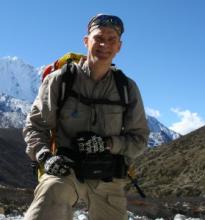IT Lessons Learned From The Top Of Mount Everest
Submitted by Tom Spring on

For anyone unfamiliar with Alan Hobson, two-time cancer survivor and three-time Mount Everest climber, his story of survival and transformation is a potent reminder of the power of determination and courage. Hobson’s life journey puts a deeper meaning into the cliché “conquer your own personal Everest,” offering tangible takeaways for personal and professional success, as well as surprising life lessons.
Hobson, an unassuming mountaineer, lacks the bravado of a billionaire Sir Richard Branson-type adventure junkie you’d expect in a three-time Everest climber. Instead, Hobson is built like a marathon runner with the passion of Tony Robbins – talking with zeal about climbing the real and metaphorical Everests in his life. ITbestofbreed.com caught up with Hobson at the Intel Solutions Summit in April.
“The parallels of IT and Everest are pretty clear. The IT industry is experiencing one of the biggest technological upheavals in the history of the planet,” Hobson said. “Companies and solution providers are faced with a massive electronic avalanche of change. These are gale-force winds of change – cloud, servers or tablets.”
Hobson said the bad news is the risks are real. “Literally millions and billions of dollars in revenue are at stake. Maybe it’s your company’s reputation or leadership within the industry. With Everest and IT, the same survival skills apply, Hobson said. Teamwork is essential on Everest and in any successful business or industry, he said.
“[Climbing] Everest is 97 percent preparation and three percent execution,” said Hobson. “If you want to climb the physical mountain, you must first climb the organizational Everest,” he said. That includes that basics – organizing the trip, raising capital and preparing your body both physically and mentally. The last part only requires climbing the mountain. Hobson’s Everest takeaways for entrepreneurs, start-ups and career-climbing professionals are to learn the secrets of what you need and your business needs to do to succeed in your own climbs and “marrying the two expeditions together.” And of course, when life throws you curve balls, in the form of cancer or business challenges, be prepared to dig deep, hold on tight and never give up.
However, Hobson warns, do not mistake the destination for the careful journey required to get there.
“What I learned was my goals in life had less to do with the (Everest) real estate at 29,029 feet up in the sky, but [were] more about the metamorphosis of who I had become to get there, what it takes to be on the mountain and what you need to endure to survive.”
Climbing Mount Everest
Hobson’s first attempt up Everest, in 1991, was cut short 3,000 feet from the summit when violent winds blew his team’s base camp tents off the face of the mountain. Undeterred, Hobson was back three years later, in 1994, only to have his dream of reaching the summit derailed under 1,000 feet from the peak when his team’s lead climber came down with high altitude sickness. The expedition was cut short when the group elected to rescue their team leader rather than continue on.
“When we returned home we were known as the expedition that failed,” Hobson said. “At moments like that, we could have let those words demoralize us, defeat us and crush us. Or we can use them to garner a greater sense of strength within ourselves to go back towards that goal again with a greater degree of commitment, conviction and, most important, the knowledge that we could do it safely without losing a team member.”
Hobson realized, “It’s OK to fail. It’s OK to be afraid. But it’s not okay to fold. So three years later we were back at Everest.”






